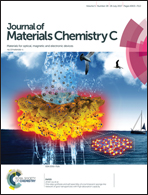Tunable electromagnetic shielding properties of conductive poly(vinylidene fluoride)/Ni chain composite films with negative permittivity†
Abstract
In this study, we fabricated various poly(vinylidene fluoride) (PVDF)/Ni-chain composites with different Ni contents using the solution processing and compression molding method. We made a detailed investigation of the dielectric permittivity, electrical conductivity, and electromagnetic interference (EMI) shielding properties of the PVDF/Ni-chain composites. With a high concentration of Ni (6 wt% and 12 wt%), the dielectric permittivity had negative values, which were due to the formation of conductive networks in the PVDF matrix. We also discussed the generation of negative permittivity, and concluded that PVDF/Ni-chains could be potentially used as “natural metamaterials.” Upon increasing the Ni content, their electrical conductivity and EMI shielding properties were improved. Moreover, the EMI shielding properties were closely related to the composite films' thicknesses. The average EMI properties of the PVDF/6 wt%-Ni composite films at thicknesses of 0.2 mm, 0.3 mm, 0.4 mm, and 0.5 mm were 15.4 dB, 24.7 dB, 30.3 dB, and 35.4 dB, respectively. The shielding mechanism was mainly governed by absorption. We also proposed the possibility of a dissipation mechanism in the PVDF/Ni-chain composite, which is related to Ni's dual loss mechanism and unique chain-like structure that formed three-dimensional nets in the PVDF matrix.

- This article is part of the themed collection: 2017 Journal of Materials Chemistry C HOT Papers


 Please wait while we load your content...
Please wait while we load your content...